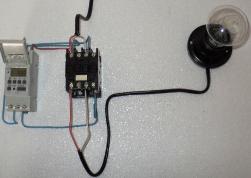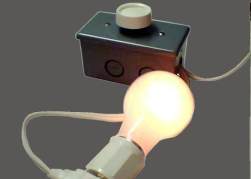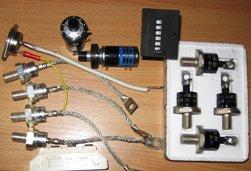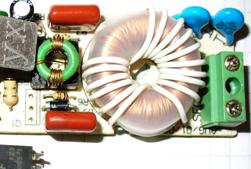How to place outlets in living rooms
 The process of placing outlets is creative on the one hand, and on the other, it requires the use of logic and accurate calculation.
The process of placing outlets is creative on the one hand, and on the other, it requires the use of logic and accurate calculation.
Let's figure out how to correctly place the sockets on the example of a standard three-room apartment with a bedroom, a nursery and a hall. There are no approved rules for the placement of outlets in the apartment. The most important rule: sockets should be enough for everything and they should be in convenient places.
In the children's room, the most appropriate placement of the outlet block is near the desktop, and you need to add an outlet on the Internet to 3-4 electrical outlets. If a TV is planned in the room, then 1-2 sockets are placed near it. You can provide a socket for a nightlight ...
Alarm clock on ... lighting! An example of using an electronic timer
 How to make lighting turn on strictly according to schedule? For example, you go to work at 7.40 and return at 17.20 and want the light to be on above the front door at that time.
How to make lighting turn on strictly according to schedule? For example, you go to work at 7.40 and return at 17.20 and want the light to be on above the front door at that time.
Imagine, come to the house, and you are already greeted by a burning lamp and you do not need to look for a switch in the dark, the light automatically turns on and after a certain time turns off independently, without your participation.
Or another example, you went to rest, but you don’t have an apartment signal, then you can create an “effect of presence”. In your absence, the light in the apartment itself will turn on and off as if no one had gone anywhere. I know people who turn off water heaters (electric titans) and electric heating boilers during the day, and turn them on only at night ...
Homemade dimmers. Part Four Thyristor Practical Devices
 The basis of dimmers and power regulators are, as a rule, thyristors and triacs. The operation of these semiconductor devices was described in the previous three parts of the article, and now you can get acquainted with the device of some practical devices on thyristors. All schemes that will be considered use the phase regulation principle described at the end of the third part of the article.
The basis of dimmers and power regulators are, as a rule, thyristors and triacs. The operation of these semiconductor devices was described in the previous three parts of the article, and now you can get acquainted with the device of some practical devices on thyristors. All schemes that will be considered use the phase regulation principle described at the end of the third part of the article.
First, let's get acquainted with fairly simple schemes containing a small amount of detail, and at least therefore, the most affordable for repetition in amateur conditions. However, the circuits may be more complex, but the algorithm for their operation is still the same - adjusting the brightness of the light source. Sometimes there are circuits that combine the dimmer and twilight switch itself, or a scheme for smoothly turning on the lamp ...
Astronomical timers for controlling lighting by time
 Nowadays, photosensors are most often used to control lighting on the street and the territory adjacent to the house. (fromtwilight switches).
Nowadays, photosensors are most often used to control lighting on the street and the territory adjacent to the house. (fromtwilight switches).
The photosensors turn on the light depending on the amount of natural light. Somehow it turned out that everyone had forgotten a little the most popular technical solution relative to the recent past - turning the lights on and off using the daily time switch.
Even before the advent of photoresistors and other photocells, various automatic devices with clockwork were actively used to automate lighting. These devices turned on and off the lights at a predetermined time of day. The principle of operation of these relays was based on the rotation of a software disk with holes ...
Homemade dimmers. Part three. How to control a thyristor?
 How to turn on the thyristor? Turn on the thyristor with direct current.
How to turn on the thyristor? Turn on the thyristor with direct current.
To answer this question you will have to assemble a simple schematic shown in the figure. 1. After the circuit is assembled, it should be connected to a constant voltage source.
The variable resistor R2 motor should be set to the lower position in the diagram. Then, while holding down the SB1 button, (the light should not still be on), slowly move the slider upwards in the diagram.
In some position of the engine, the lamp will light up, after which the button should be released, thereby removing the signal from the UE. After releasing the button, the light should remain on. How can all this be explained? By rotating the resistor R2 engine, we increased the current ...
How are compact fluorescent lamps
 The first fluorescent lamps were created in the USA in the 30s of the last century. Their active implementation began in the 50s and 60s. Currently, fluorescent lamps in their distribution occupy the second place in the world after incandescent lamps.
The first fluorescent lamps were created in the USA in the 30s of the last century. Their active implementation began in the 50s and 60s. Currently, fluorescent lamps in their distribution occupy the second place in the world after incandescent lamps.
One of the main disadvantages of conventional linear fluorescent lamps is their size. Manufacturers of fluorescent lamps have always sought to reduce their size. And only in the 80s after the creation of new high-quality phosphors it was possible to reduce the diameter of the lamp tube to 12 mm and bent it many times to get a lamp with a compact design. Over time, lamp manufacturers managed to reduce their size and weight so much that they became able to replace incandescent lamps almost everywhere. So a compact fluorescent lamp was born ...
Overview of different types of circuit breakers with prices and features
 Circuit breakers are present in any modern building, usually they are mounted on a 35mm DIN rail. The exception is the previously widely used black “automatic machines” of the AE series, which are now better not to use, because they are inferior to modern in all respects except the price.
Circuit breakers are present in any modern building, usually they are mounted on a 35mm DIN rail. The exception is the previously widely used black “automatic machines” of the AE series, which are now better not to use, because they are inferior to modern in all respects except the price.
Circuit breakers (automatic machines) are devices for protecting electrical circuits from overloads and short circuit currents.
A critical situation in the electrical circuit occurs when the load is too powerful, or during a short circuit. To understand how the circuit breaker saves in these situations, you need to understand its principle of operation. When the current in the circuit of the machine exceeds the working one by a factor of several, the thermal release is activated ...
Homemade dimmers. Part two. Thyristor device
 After the device and use of the dynistor have been considered, it will be easier to understand the device and the operation of the trinistor. However, most often the trinistor is simply called a thyristor, somehow more familiar.
After the device and use of the dynistor have been considered, it will be easier to understand the device and the operation of the trinistor. However, most often the trinistor is simply called a thyristor, somehow more familiar.
The device triode thyristor (trinistor) shown in the figure. In the figure, everything is shown in sufficient detail and in general, with the exception of another case, it resembles a dinistor device. The connection diagram of the load and the battery is the same as that of the dinistor.
In both cases, the power source is conventionally shown as a battery in order to see the polarity of the connection. The only new element in this figure is the UE control electrode connected, as already mentioned, to one of the regions of the “layered” semiconductor crystal ...
Homemade dimmers. Part one. Types of Thyristors
 The article describes the use of thyristors, provides simple and illustrative experiments to study the principles of their operation. Practical instructions for checking and selecting thyristors are also given.
The article describes the use of thyristors, provides simple and illustrative experiments to study the principles of their operation. Practical instructions for checking and selecting thyristors are also given.
The articles “Dimmers: device, varieties and connection methods” and “Device and circuit of a dimmer” described the use of industrial dimmers. But, despite the variety and availability of such devices on sale, sometimes still, you have to remember the forgotten old, and assemble the dimmer according to a fairly simple amateur scheme.
The power of the device that is on sale may be insufficient, or there are simply parts so that they are not stupidly lost, so let there be at least something. In addition, the dimmer does not have to regulate the light at all ...
Open wiring - popular wiring methods
Laying methods and materials used in open wiring.
R There are two types of wiring - it is hidden and open. As a rule, hidden wiring is better than open in terms of room design and energy performance, as wires under a layer of plaster are cooled better than in the open air and their routes and junction boxes do not interfere with the arrangement of furniture and equipment.
There are two types of wiring - it is hidden and open. As a rule, hidden wiring is better than open in terms of room design and energy performance, as wires under a layer of plaster are cooled better than in the open air and their routes and junction boxes do not interfere with the arrangement of furniture and equipment.
However, in addition to the advantages, hidden wiring has its drawbacks. This is the need for wall shredding and their subsequent restoration, the complexity of the work performed, construction waste, the need to stop technological processes inside the premises, the complexity of subsequent diagnostics and modernization. Open wiring is often done inside buildings when changing ownership; it is much faster, cheaper, and you can easily add or remove its segments in the future ...
How are solar panels arranged and work?
 Nowadays, almost everyone can assemble and get at their disposal their independent source of solar-powered electricity (in the scientific literature they are called photovoltaic panels).
Nowadays, almost everyone can assemble and get at their disposal their independent source of solar-powered electricity (in the scientific literature they are called photovoltaic panels).
Costly equipment is compensated over time by the ability to receive free electricity. It is important that solar panels are an environmentally friendly source of energy. In recent years, prices for photovoltaic panels have dropped tenfold and they continue to decline, which indicates great prospects for their use.
In a classic form, such a source of electricity will consist of the following parts: directly, a solar battery (DC generator), a battery with a charge control device and an inverter ...
How to make a power supply from an electronic transformer
 After all that has been said in the previous article, it seems that making a switching power supply from an electronic transformer is quite simple: put on the output a rectifier bridge, a smoothing capacitor, if necessary a voltage regulator and connect the load. However, this is not quite true.
After all that has been said in the previous article, it seems that making a switching power supply from an electronic transformer is quite simple: put on the output a rectifier bridge, a smoothing capacitor, if necessary a voltage regulator and connect the load. However, this is not quite true.
The fact is that the converter does not start without load or the load is not sufficient: if you connect an LED to the rectifier output, of course, with a limiting resistor, you will be able to see only one flash of the LED when it is turned on.
To see another flash, you will need to turn off and on the converter to the network. In order for the flash to turn into a constant glow, an additional load must be connected to the rectifier ...
